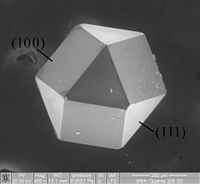
Photo from wikipedia
Abstract In this study, the corrosion behaviors of bioactive element coatings on plasma electrolytic oxidation (PEO)-treated Ti-6Al-4V alloys were researched using various instruments for measurement of coated elements from PEO-treated… Click to show full abstract
Abstract In this study, the corrosion behaviors of bioactive element coatings on plasma electrolytic oxidation (PEO)-treated Ti-6Al-4V alloys were researched using various instruments for measurement of coated elements from PEO-treated surface in the solution of simulated fluid. For this research, Ti-6Al-4V ELI disks were prepared as the substrates for PEO treatment. PEO treatment was carried out using pulsed DC power supply at 280 V for 3 min in electrolytes containing bioactive ions such as silicon, zinc, manganese, magnesium, strontium, calcium, and phosphorus. To analyze the electrochemical properties of the PEO film as a function of added ions in the electrolyte, potentiodynamic and AC impedance tests were performed using a potentiostat in 0.9% NaCl solution. The alloy surface after performing a corrosion test of the PEO-treated specimen on the Ti-6Al-4V alloy was observed using a field-emission scanning microscope, energy dispersive X-ray spectrometer, and X-ray diffractometer (XRD). When a bioactive element was added during the PEO process, the pore size decreased and a precipitate containing a high Mn content was formed around the pores. The XRD results of the PEO-treated surface with bioactive elements showed that the anatase and HA phase contents increased while the Ti peak intensity decreased. When Mn was added to the electrolyte, a second anodic peak appeared, and the precipitates on the surface and pore edges were dissolved in the 0.9% NaCl solution. The results of AC impedance tests revealed a decrease in the polarization resistance of the PEO-treated surface.
Journal Title: Surface and Coatings Technology
Year Published: 2019
Link to full text (if available)
Share on Social Media: Sign Up to like & get
recommendations!